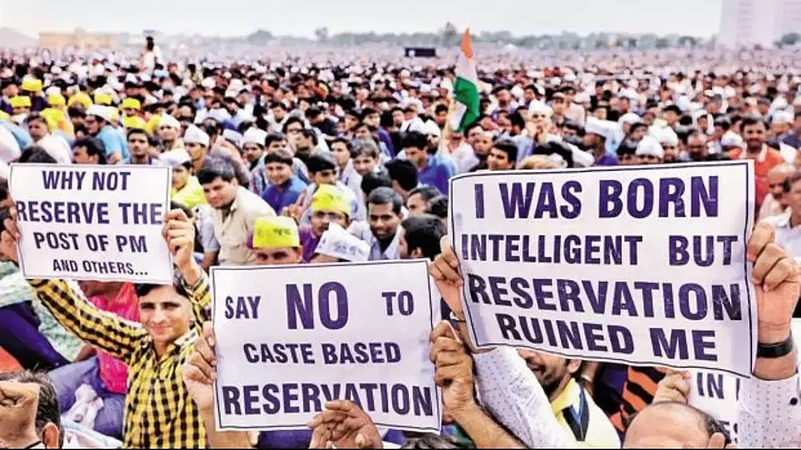Some government decisions that have brought forth a foundational change in Indian politics have often been questioned on the basis of whether they were driven purely by an instinct of political conviction or political opportunism or survival on part of the politicians/parties. The decision to implement the Mandal Commission report’s recommendations by the VP Singh government on August 7 1990 was one such decision, whose impact continues to be felt today in the country's political and social makeup.
The impact of Mandal politics can be felt to this day. According to journalist and author Neelanjan Mukhopadhyay, the Mandal phenomenon not only gave a legitimacy to social justice parties and populist politics but also provided leaders with a platform to fearlessly use polarising religious narratives to counter the socialist trends in politics and articulate their ideology.
Social justice or political opportunism?
The Mandal Commission or the Socially and Educationally Backward Classes Commission, was established in India in 1979 by the Janata Party government under Prime Minister Morarji Desai with a mandate to "identify the socially or educationally backward classes" of India.
The Commission’s recommendations were justified by Article 15 (4) of the Constitution of India which states that “Nothing in this Article or in clause(2) of Article 29 shall prevent the State from making any provision for the advancement of any socially or educationally backward classes of citizens or for Scheduled Castes and Scheduled tribes".
The implementation of the report’s recommendations caused a huge upheavel, backlash and protests especially among students from the “General” (upper caste) category. Earlier, only about 25 percent o the population in India that was classified as SC or ST was eligible for reservation. Following the Janata government’s decision to implement the Mandal Commission in 1990, 50 petite people of India who belonged to the Other Backward Classes also became eligible for reservation. This meant that all of a sudden, nearly 75 percent of the Indian population was covered by reservations.
Many observes and critics of VP Singh believe that his move to implement Mandal was a response to the rising mandir-politics of the Sangh Parivar, and by extension the BJP with which it was in alliance. In the late 1980s and 1990, VP Singh was faced with growing factionalism within the Janata Dal, a personal power tussle with party stalwart Devi Lal Chautala, and the threat of the growing influence of the Sangh Parivar’s call to unify Hindus under the umbrella of the Ram Mandir Andolan.
Rise of Kamandal
Singh’s move to implement the Mandal Commission reports which had been lying dormant for over a decade is seen by many as a move to save his power. Nevertheless, the implementation of the Mandal Commission’s report by the Janata Dal government was projected and perceived by many as a social revolution and a classic example of affirmative action.
According to journalist and author Neelanjan Mukhopadhyay, however, the Mandal phenomenon not only gave a legitimacy to social justice parties and populist politics but also provided leaders with a platform to fearlessly use polarising religious narratives to counter the socialist trends in politics and articulate their ideology.
Implementing Mandal pitted the two political ideologies against each other. Mandal vs Kamandal.
On the one side were those who said that Hindu same was fractured by sati, which is primary source of conflict. Those opposed to Mandal harped on Hindu solidarity and need to unite all Hindus to oppose Mondal commission’s moves.
The Mandal politics played a decisive role in helping the BJP’s political fortunes. In the 1984 Lok Sabha elections, the party had only won two seats. However, its growing popularity allowed it to become an ally and form a coalition government with the VP Singh led Janata Dal government in 1989-90. Researcher Mehwish Hafeez in her 2015 paper named ‘The Anatomy of the Modi Phenomenon – How Should Pakistan Deal With It?’ noted that the government’s decision to implement Mandal “provided the BJP with a golden opportunity to raise its profile”.
The move put BJP in a dilemma - “on one hand, it had to address the concerns of upper caste Hindus and, on the other hand, it had to take into account the interests of the lower caste Hindus from whom it drew its electoral strength”, Hafeez notes. Instead of fragmenting its voter base, however, the party responded with a brilliant plan to unify all Hindus under its umbrella.
In north India, this played out in the form of “Rath Yatra”, led by LK Advani to unite all Hindus. “This tactic of combining the Temple issue and Mandal recommendations helped the BJP increase its vote share from 7.5 per cent in 1984 elections to 21 per cent in 1991.12 Subsequently, the BJP was able to form a coalition government under Vajpayee after winning 161 seats in the Lok Sabha in 1996,” Hafeez noted.
In the 2010 paper ‘From Navnirman to the anti-Mandal riots: the political trajectory of Gujarat (1974–1985)’ researcher Nagindas Sanghavi noted that in electorally polarised states like Gujarat, “Congress's caste arithmetic and the KHAM policy alienated upper castes and ultimately provoked the anti-Mandal riots in 1985, which later turned anti-Muslim. The anti-reservation agitations coincided with the mobilization of Hindu right-wing forces and eventually helped consolidate the eventual political rise of the BJP in Gujarat”.
Caste-votebank politics
It is naive to think that implementation of the Mandal report was driven entirely due to social upliftment.
OBC’s form a large section of voters in India and in North India, they have traditionally not been with the Congress.
In the book ‘The Disruptor: How Vishwanath Pratap Singh Shook India’, author Debashish Mukerji writes that “Shudras — the bulk of peasants and rural service providers who form the mainstay of rural society, many of whom (though, importantly, not all) came to be classified as the OBCs” after the 1980s. Mukerji notes that though the peasants among them were big gainers from the Congress’s land-reform drive and OBC communities had faced less discrimination from upper castes than Dalits, the communities stayed away from Congress due to the dominance of upper caste leaders in the party’s top echelons who refused to share power.
In North India, the OBCs posed an even bigger challenge to Congress than in the South where the party was in favour with several peasant caste groups and communities. The party had continued to woo upper caste votes in north India since the the OBC vote remained scattered mainly due to poor political awareness, meaning the party continued to ignore it. In the South, however, Congress had to woo other castes since upper castes were not a majority.
Despite the fact that the Brahmins, Kshatriyas and Vaishyas together averaged merely 20 per cent of the population at the time with Dalits about 15 per cent and Muslims another 13-15 per cent, the OBC vote remained divided with politicised sections supporting socialist parties like the SSP.
Till the 1950s, the only reservation in North Indian states was for Dalits and tribals. Since the OBCs did not vote for Congress, the party did not care about seeking reservations for them. OBC reservations would also run the chance of angering the party’s upper caste leaders and voters. Nevertheless, following the inclusion of Article 340 in the Indian Constitution, a commission chaired by former freedom fighter, social reformer and writer Dattatreya Balakrishna (Kaka) Kalelkar was set up in 1953 with a view ‘to investigate the conditions of socially and educationally backward classes … and the difficulties under which they labour, and to make recommendations as to the steps that should be taken … to remove such difficulties and improve their condition’.
The report identified listing 2,399 castes countrywide as OBCs and recommending 25-40 per cent reservation for them in different categories of Central government service.
The report’s recommendation were never implemented. Critics claim it was because the Congress feared upsetting its upper-caste voters in north India. Mukherjee noted that the party was however “anxious to not lose the OBC votes it drew in the south and the west (which it might have if it dismissed the report entirely)” and thus it came up with a compromise: while it did nor allow OBC quota in Central government jobs, state governments were free to set up their own commissions to identify state-level OBCs and reserve jobs for them if they wanted.
The demand for 60 percent reservations which parties like SSP, PSP offered OBCs, however, became stronger among the community.
The Congress party in later decades saw and influx of socialist leaders and the resignation of Charan Singh prompted a series of defections with many leaders choosing to join his political alternative instead of remaining with the Congress.
“When the Janata Party was formed after the Emergency, both Charan Singh’s BLD and the remnants of the socialist parties joined it, cooperating closely thereafter, further consolidating the OBCs politically”, Mukherjee writes. While the Janata Party’s victory in the March 1977 general elections was no doubt a reassertion of democracy against Indira’s dictatorship, Mukherjee notes how it was also seen in north India as a victory of the OBCs over the upper-caste–Scheduled Caste combine.
The Janta Dal government decided to implement the recommendations of the Kalelkar report. However, by 1979, tussle within the party and shortcomings of the report itself prompted the VP Singh government to set up another commission under BP Mondal to carry out the same task as the Kalelkar Commission. It was this decision that ultimately led to his fall.
VP Singh’s failure to effectively control the political cost of the protests escalating enough to close parts of the nation was one of the primary reasons for the fall of the Janata Party government.
Over three decades later, the Supreme Court of India’s decision to uphold the long held demand for 10 per cent reservation for the economically weaker section (EWS) among forward castes in government jobs and colleges across India in November this year has once again brought the spotlight on the Mandal-Kamandal debate. The centre has justified the 10 percent quota for Economically Weaker Sections as a constitutional obligation that the government has to extend helping hands to the poor. However, critics have said that the EWS quota is also caste discriminatory as by stipulating a quota for non-SC-ST-OBC families earning Rs 8,00,000 (Rs 8 lakh; nearly $9,800) per annum or less, the government is effectively creating a quota exclusively for upper castes who are not in the top 1 percent of the income distribution.
How the decision impacts future politics of the country remains to be seen.


























